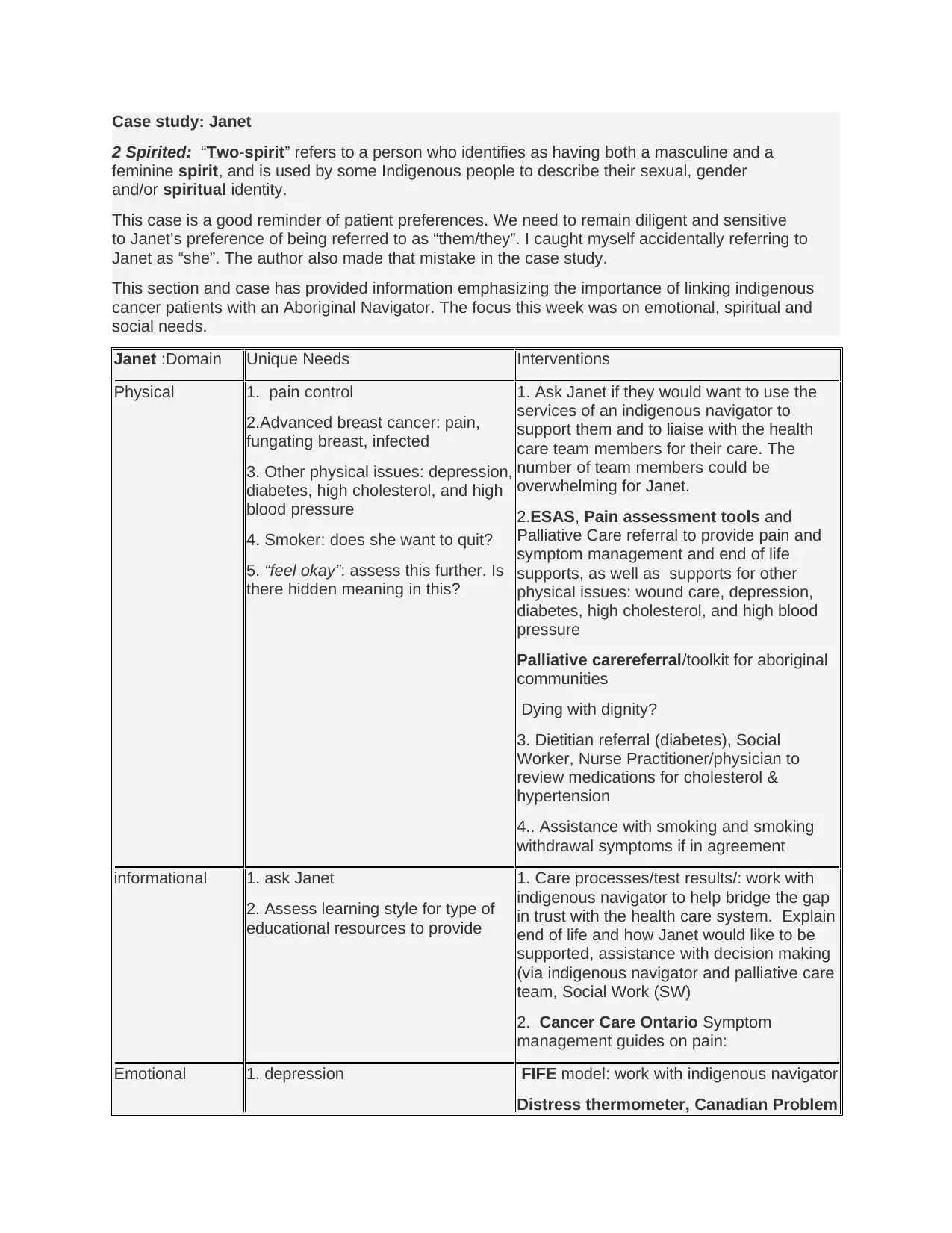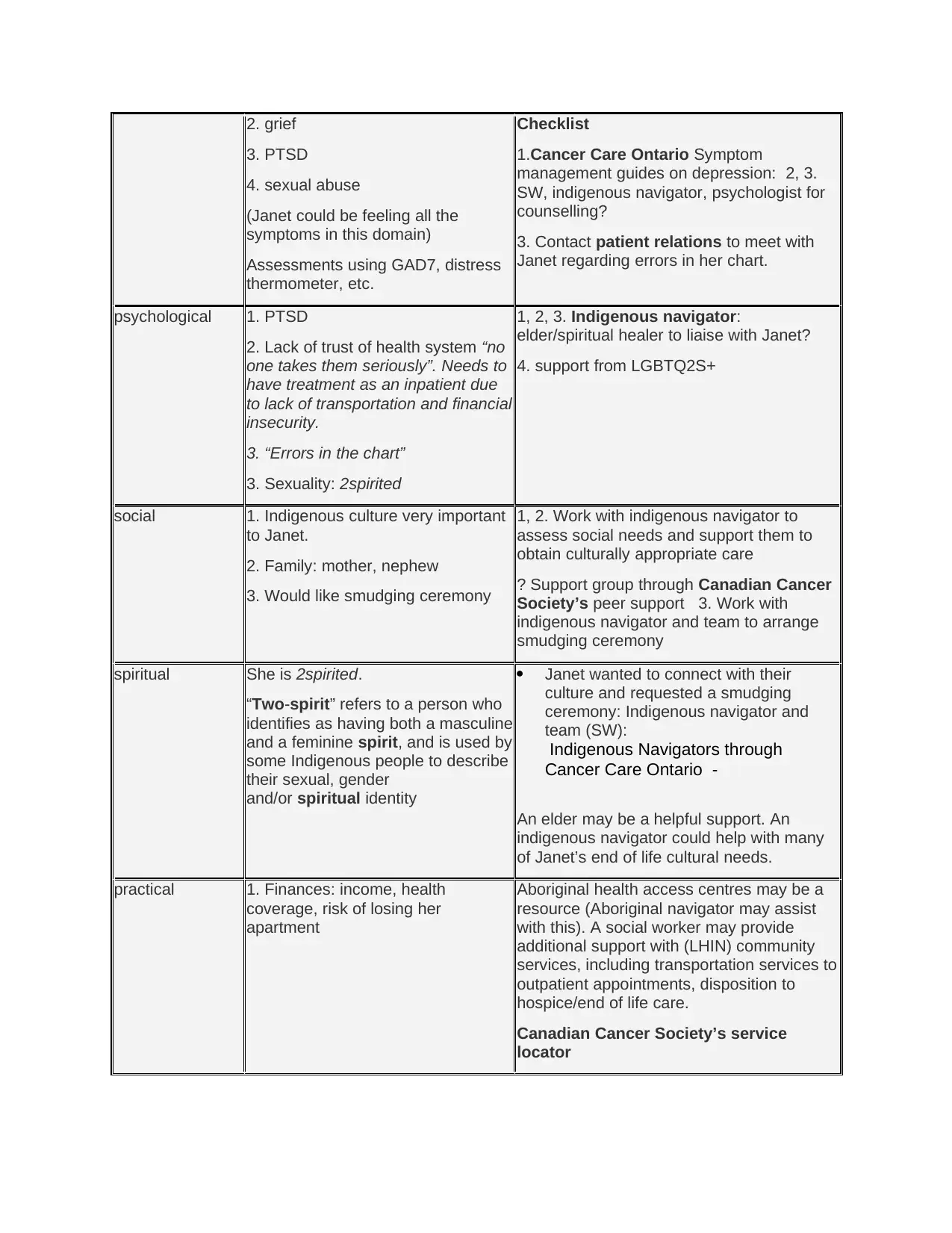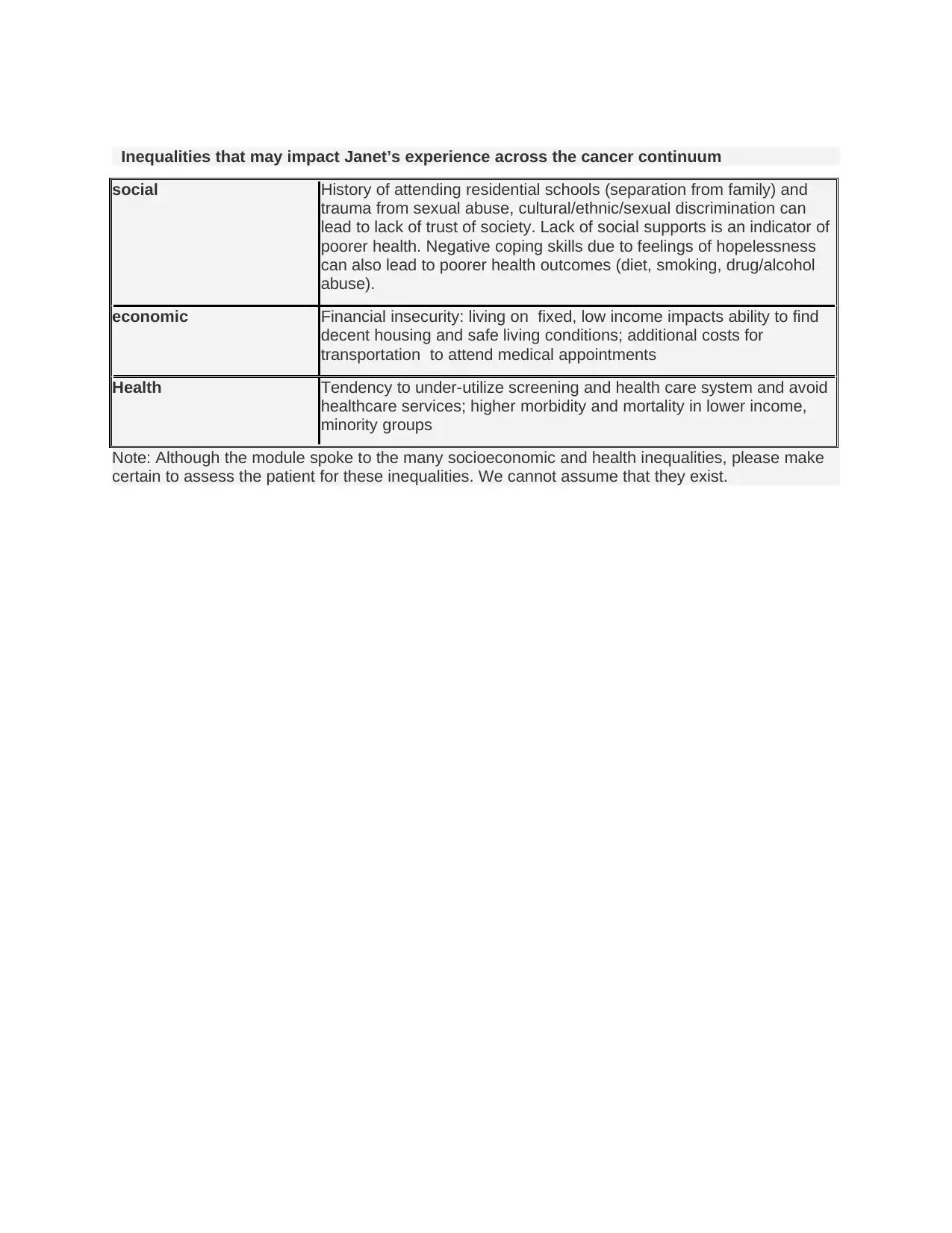Case Study: Janet 2 Spirited - Addressing Patient Needs in Healthcare
VerifiedAdded on 2022/10/27
|3
|942
|69
Case Study
AI Summary
This case study focuses on Janet, a two-spirited Indigenous patient with advanced breast cancer, emphasizing the importance of patient preferences and culturally sensitive care. The analysis highlights Janet's unique needs across physical, emotional, spiritual, social, and practical domains. Interventions include pain management, palliative care, emotional support through counseling and Indigenous navigators, and addressing financial and social inequalities. The case underscores the significance of connecting Indigenous cancer patients with Aboriginal navigators to bridge trust gaps, provide culturally appropriate care, and ensure comprehensive support throughout their healthcare journey. The study also addresses the impact of socioeconomic factors and health inequalities on Janet's experience, emphasizing the need for thorough patient assessment.

Case study: Janet
2 Spirited: “Two-spirit” refers to a person who identifies as having both a masculine and a
feminine spirit, and is used by some Indigenous people to describe their sexual, gender
and/or spiritual identity.
This case is a good reminder of patient preferences. We need to remain diligent and sensitive
to Janet’s preference of being referred to as “them/they”. I caught myself accidentally referring to
Janet as “she”. The author also made that mistake in the case study.
This section and case has provided information emphasizing the importance of linking indigenous
cancer patients with an Aboriginal Navigator. The focus this week was on emotional, spiritual and
social needs.
Janet :Domain Unique Needs Interventions
Physical 1. pain control
2.Advanced breast cancer: pain,
fungating breast, infected
3. Other physical issues: depression,
diabetes, high cholesterol, and high
blood pressure
4. Smoker: does she want to quit?
5. “feel okay”: assess this further. Is
there hidden meaning in this?
1. Ask Janet if they would want to use the
services of an indigenous navigator to
support them and to liaise with the health
care team members for their care. The
number of team members could be
overwhelming for Janet.
2.ESAS, Pain assessment tools and
Palliative Care referral to provide pain and
symptom management and end of life
supports, as well as supports for other
physical issues: wound care, depression,
diabetes, high cholesterol, and high blood
pressure
Palliative carereferral/toolkit for aboriginal
communities
Dying with dignity?
3. Dietitian referral (diabetes), Social
Worker, Nurse Practitioner/physician to
review medications for cholesterol &
hypertension
4.. Assistance with smoking and smoking
withdrawal symptoms if in agreement
informational 1. ask Janet
2. Assess learning style for type of
educational resources to provide
1. Care processes/test results/: work with
indigenous navigator to help bridge the gap
in trust with the health care system. Explain
end of life and how Janet would like to be
supported, assistance with decision making
(via indigenous navigator and palliative care
team, Social Work (SW)
2. Cancer Care Ontario Symptom
management guides on pain:
Emotional 1. depression FIFE model: work with indigenous navigator
Distress thermometer, Canadian Problem
2 Spirited: “Two-spirit” refers to a person who identifies as having both a masculine and a
feminine spirit, and is used by some Indigenous people to describe their sexual, gender
and/or spiritual identity.
This case is a good reminder of patient preferences. We need to remain diligent and sensitive
to Janet’s preference of being referred to as “them/they”. I caught myself accidentally referring to
Janet as “she”. The author also made that mistake in the case study.
This section and case has provided information emphasizing the importance of linking indigenous
cancer patients with an Aboriginal Navigator. The focus this week was on emotional, spiritual and
social needs.
Janet :Domain Unique Needs Interventions
Physical 1. pain control
2.Advanced breast cancer: pain,
fungating breast, infected
3. Other physical issues: depression,
diabetes, high cholesterol, and high
blood pressure
4. Smoker: does she want to quit?
5. “feel okay”: assess this further. Is
there hidden meaning in this?
1. Ask Janet if they would want to use the
services of an indigenous navigator to
support them and to liaise with the health
care team members for their care. The
number of team members could be
overwhelming for Janet.
2.ESAS, Pain assessment tools and
Palliative Care referral to provide pain and
symptom management and end of life
supports, as well as supports for other
physical issues: wound care, depression,
diabetes, high cholesterol, and high blood
pressure
Palliative carereferral/toolkit for aboriginal
communities
Dying with dignity?
3. Dietitian referral (diabetes), Social
Worker, Nurse Practitioner/physician to
review medications for cholesterol &
hypertension
4.. Assistance with smoking and smoking
withdrawal symptoms if in agreement
informational 1. ask Janet
2. Assess learning style for type of
educational resources to provide
1. Care processes/test results/: work with
indigenous navigator to help bridge the gap
in trust with the health care system. Explain
end of life and how Janet would like to be
supported, assistance with decision making
(via indigenous navigator and palliative care
team, Social Work (SW)
2. Cancer Care Ontario Symptom
management guides on pain:
Emotional 1. depression FIFE model: work with indigenous navigator
Distress thermometer, Canadian Problem
Paraphrase This Document
Need a fresh take? Get an instant paraphrase of this document with our AI Paraphraser

2. grief
3. PTSD
4. sexual abuse
(Janet could be feeling all the
symptoms in this domain)
Assessments using GAD7, distress
thermometer, etc.
Checklist
1.Cancer Care Ontario Symptom
management guides on depression: 2, 3.
SW, indigenous navigator, psychologist for
counselling?
3. Contact patient relations to meet with
Janet regarding errors in her chart.
psychological 1. PTSD
2. Lack of trust of health system “no
one takes them seriously”. Needs to
have treatment as an inpatient due
to lack of transportation and financial
insecurity.
3. “Errors in the chart”
3. Sexuality: 2spirited
1, 2, 3. Indigenous navigator:
elder/spiritual healer to liaise with Janet?
4. support from LGBTQ2S+
social 1. Indigenous culture very important
to Janet.
2. Family: mother, nephew
3. Would like smudging ceremony
1, 2. Work with indigenous navigator to
assess social needs and support them to
obtain culturally appropriate care
? Support group through Canadian Cancer
Society’s peer support 3. Work with
indigenous navigator and team to arrange
smudging ceremony
spiritual She is 2spirited.
“Two-spirit” refers to a person who
identifies as having both a masculine
and a feminine spirit, and is used by
some Indigenous people to describe
their sexual, gender
and/or spiritual identity
Janet wanted to connect with their
culture and requested a smudging
ceremony: Indigenous navigator and
team (SW):
Indigenous Navigators through
Cancer Care Ontario -
An elder may be a helpful support. An
indigenous navigator could help with many
of Janet’s end of life cultural needs.
practical 1. Finances: income, health
coverage, risk of losing her
apartment
Aboriginal health access centres may be a
resource (Aboriginal navigator may assist
with this). A social worker may provide
additional support with (LHIN) community
services, including transportation services to
outpatient appointments, disposition to
hospice/end of life care.
Canadian Cancer Society’s service
locator
3. PTSD
4. sexual abuse
(Janet could be feeling all the
symptoms in this domain)
Assessments using GAD7, distress
thermometer, etc.
Checklist
1.Cancer Care Ontario Symptom
management guides on depression: 2, 3.
SW, indigenous navigator, psychologist for
counselling?
3. Contact patient relations to meet with
Janet regarding errors in her chart.
psychological 1. PTSD
2. Lack of trust of health system “no
one takes them seriously”. Needs to
have treatment as an inpatient due
to lack of transportation and financial
insecurity.
3. “Errors in the chart”
3. Sexuality: 2spirited
1, 2, 3. Indigenous navigator:
elder/spiritual healer to liaise with Janet?
4. support from LGBTQ2S+
social 1. Indigenous culture very important
to Janet.
2. Family: mother, nephew
3. Would like smudging ceremony
1, 2. Work with indigenous navigator to
assess social needs and support them to
obtain culturally appropriate care
? Support group through Canadian Cancer
Society’s peer support 3. Work with
indigenous navigator and team to arrange
smudging ceremony
spiritual She is 2spirited.
“Two-spirit” refers to a person who
identifies as having both a masculine
and a feminine spirit, and is used by
some Indigenous people to describe
their sexual, gender
and/or spiritual identity
Janet wanted to connect with their
culture and requested a smudging
ceremony: Indigenous navigator and
team (SW):
Indigenous Navigators through
Cancer Care Ontario -
An elder may be a helpful support. An
indigenous navigator could help with many
of Janet’s end of life cultural needs.
practical 1. Finances: income, health
coverage, risk of losing her
apartment
Aboriginal health access centres may be a
resource (Aboriginal navigator may assist
with this). A social worker may provide
additional support with (LHIN) community
services, including transportation services to
outpatient appointments, disposition to
hospice/end of life care.
Canadian Cancer Society’s service
locator

Inequalities that may impact Janet’s experience across the cancer continuum
social History of attending residential schools (separation from family) and
trauma from sexual abuse, cultural/ethnic/sexual discrimination can
lead to lack of trust of society. Lack of social supports is an indicator of
poorer health. Negative coping skills due to feelings of hopelessness
can also lead to poorer health outcomes (diet, smoking, drug/alcohol
abuse).
economic Financial insecurity: living on fixed, low income impacts ability to find
decent housing and safe living conditions; additional costs for
transportation to attend medical appointments
Health Tendency to under-utilize screening and health care system and avoid
healthcare services; higher morbidity and mortality in lower income,
minority groups
Note: Although the module spoke to the many socioeconomic and health inequalities, please make
certain to assess the patient for these inequalities. We cannot assume that they exist.
social History of attending residential schools (separation from family) and
trauma from sexual abuse, cultural/ethnic/sexual discrimination can
lead to lack of trust of society. Lack of social supports is an indicator of
poorer health. Negative coping skills due to feelings of hopelessness
can also lead to poorer health outcomes (diet, smoking, drug/alcohol
abuse).
economic Financial insecurity: living on fixed, low income impacts ability to find
decent housing and safe living conditions; additional costs for
transportation to attend medical appointments
Health Tendency to under-utilize screening and health care system and avoid
healthcare services; higher morbidity and mortality in lower income,
minority groups
Note: Although the module spoke to the many socioeconomic and health inequalities, please make
certain to assess the patient for these inequalities. We cannot assume that they exist.
⊘ This is a preview!⊘
Do you want full access?
Subscribe today to unlock all pages.

Trusted by 1+ million students worldwide
1 out of 3
Your All-in-One AI-Powered Toolkit for Academic Success.
+13062052269
info@desklib.com
Available 24*7 on WhatsApp / Email
![[object Object]](/_next/static/media/star-bottom.7253800d.svg)
Unlock your academic potential
Copyright © 2020–2025 A2Z Services. All Rights Reserved. Developed and managed by ZUCOL.
